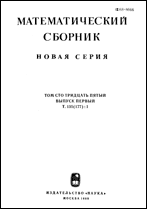|
Free subgroups and compact elements of connected Lie groups
M. I. Kabenyuk
Abstract:
Let $\Omega_G$ be the set of compact (i.e., contained in some compact subgroup) elements of a topological group $G$, and let $\overline{\Omega}_G$ be its closure. The following assertions are proved:
Theorem 1. A compact connected semisimple Lie group $G$ has a free dense subgroup each of whose nonidentity elements is a generator of a maximal torus in $G$.
Theorem 2. {\it Suppose that a connected Lie group $G$ has no nontrivial compact elements in its center and coincides with the closure of its commutator group, and let $\mathscr{G}$ be its Lie algebra. The following conditions are equivalent:
{(i)} $\overline{\Omega}_G = G$.
{(ii)} $G$ has a dense subgroup of compact elements.
{(iii)} $\mathscr{G} = \mathscr{S} \oplus\mathscr{V}$, where $\mathscr{V}$ is a nilpotent ideal and $\mathscr{S}$ is a semisimple compact algebra whose adjoint action on $\mathscr{V}$ does not have a zero weight.
{(iv)} $G=SV$, where $V$ is a nilpotent connected simply connected normal subgroup and $S$ is a semisimple compact connected subgroup whose center $Z(S)$ acts (by conjugations) regularly on $V$.}
Corollary. {\it A locally compact connected group $G$ that coincides with the closure of its commutator group has a dense subgroup of compact elements if and only if $\overline{\Omega}_G = G$.}
Bibliography: 16 titles.
Received: 09.07.1983 and 19.10.1984
Citation:
M. I. Kabenyuk, “Free subgroups and compact elements of connected Lie groups”, Math. USSR-Sb., 55:1 (1986), 273–283
Linking options:
https://www.mathnet.ru/eng/sm1970https://doi.org/10.1070/SM1986v055n01ABEH003004 https://www.mathnet.ru/eng/sm/v169/i2/p272
|


| Statistics & downloads: |
| Abstract page: | 348 | | Russian version PDF: | 88 | | English version PDF: | 16 | | References: | 61 |
|




 Contact us:
Contact us: Terms of Use
Terms of Use
 Registration to the website
Registration to the website Logotypes
Logotypes







 Citation in format
Citation in format 